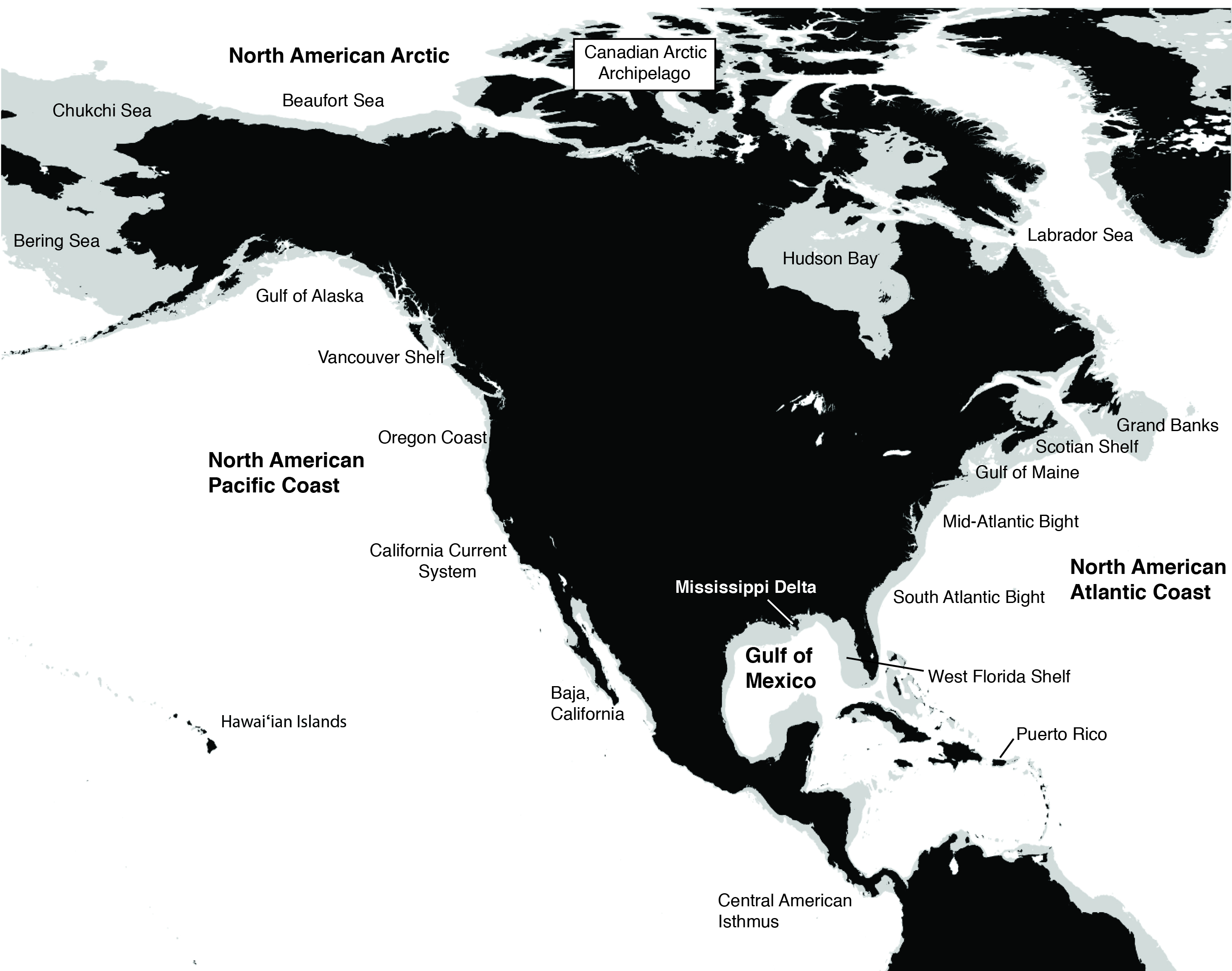<b>Fennel</b>, K., S. R. Alin, L. Barbero, W. Evans, T. Bourgeois, S. R. Cooley, J. Dunne, R. A. Feely, J. M. Hernandez-Ayon, C. Hu, X. Hu, S. E. Lohrenz, F. Muller-Karger, R. G. Najjar, L. Robbins, J. Russell, E. H. Shadwick, S. Siedlecki, N. Steiner, D. Turk, P. Vlahos, and Z. A. Wang, 2018: Chapter 16: Coastal ocean and continental shelves. In Second State of the Carbon Cycle Report (SOCCR2): A Sustained Assessment Report [Cavallaro, N., G. Shrestha, R. Birdsey, M. A. Mayes, R. G. Najjar, S. C. Reed, P. Romero-Lankao, and Z. Zhu (eds.)]. U.S. Global Change Research Program, Washington, DC, USA, pp. 649-688, https://doi.org/10.7930/ SOCCR2.2018.Ch16.
Coastal Ocean and Continental Shelves
Along ocean margins, the atmospheric, terrestrial, sedimentary, and deep-ocean carbon reservoirs meet, resulting in quantitatively significant carbon exchanges. Anthropogenic activities lead to secular trends in these exchanges. The drivers underlying these trends include rising atmospheric carbon dioxide (CO2) levels, climate-driven changes in atmospheric forcing (e.g., winds and heat fluxes) and the hydrological cycle (e.g., freshwater input from rivers), and changes in riverine and atmospheric nutrient inputs from agricultural activities and fossil fuel burning. The collective impact of these factors on carbon processing and exchanges along ocean margins is complex and difficult to quantify (Regnier et al., 2013).
This chapter focuses on two particularly pressing issues within the much broader topic of carbon cycling along ocean margins: 1) the uptake of atmospheric CO2 and subsequent export to the deep ocean and 2) patterns and drivers of coastal ocean acidification. The first is relevant to overall quantification of the ocean’s uptake of CO2. The second is directly relevant to coastal ecosystem health, fisheries, and aquaculture.
Two different terms will be used here when referring to ocean margins: 1) the coastal ocean, defined in this report as nonestuarine waters within 200 nautical miles (370 km) of the coast, and 2) continental shelves, which refer to the submerged margins of the continental plates, operationally defined here as regions with water depths shallower than 200 m (indicated in gray in Figure 16.1). Although the two definitions overlap, there are important reasons for considering both. Along passive margins with broad shelves like the North American Atlantic Coast, the continental shelf is the relevant spatial unit for discussing carbon fluxes. Along active margins with narrow shelves, such as the North American Pacific Coast, a larger region than just the shelf needs to be considered to meaningfully discuss coastal carbon dynamics. The 370-km limit chosen here to define the coastal ocean was recommended by Hales et al. (2008) and corresponds to the Exclusive Economic Zone (EEZ, the region where a nation can claim exclusive rights for fishing, drilling, and other economic activities). Worth noting here is that ocean CO2 uptake or loss is not credited to any nation under Intergovernmental Panel on Climate Change (IPCC) CO2 accounting; instead, ocean uptake is viewed as an internationally shared public commons.
Figure 16.1: North American Shelf Seas
This chapter builds on and extends several previous synthesis and planning activities, including a report by the North American Continental Margins Working Group (Hales et al., 2008), the First State of the Carbon Cycle Report (SOCCR1; CCSP 2007; Chavez et al., 2007), and activities within the North American coastal interim synthesis (Benway et al., 2016; Alin et al., 2012; Najjar et al., 2012; Mathis and Bates 2010; Robbins et al., 2009). SOCCR1 (Chavez et al., 2007) concluded that carbon fluxes for North American ocean margins were not well quantified because of insufficient observations and the complexity and highly localized spatial variability of coastal carbon dynamics. The report was inconclusive as to whether North American coastal waters act as an overall source or sink of atmospheric CO2.
The objective here is to provide a review and synthesis of recent findings with respect to coastal carbon uptake and ocean acidification for the margins of North America. Summarized first are the key variables and fluxes relevant to carbon budgets for coastal waters, followed by descriptions of 1) the mechanisms by which carbon can be removed from the atmospheric reservoir and 2) the means for quantifying the resulting carbon removal (see Section 16.2). Next presented is available research relevant to carbon budgets for North American coastal waters by region, along with an assessment of whether enough information is available to derive robust estimates of carbon export to the open ocean (see Section 16.3). Climate-driven trends in coastal carbon fluxes and coastal ocean acidification are then discussed (see Section 16.4), followed by conclusions (see Section 16.5).
See Full Chapter & References
